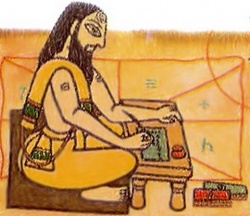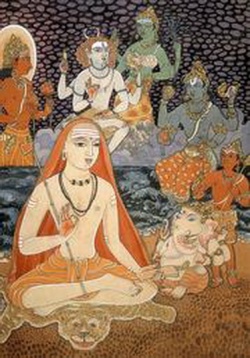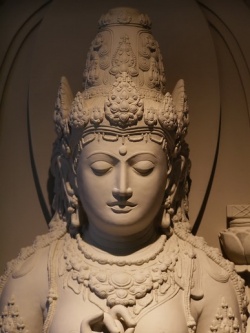Pāṇini
Pāṇini (Sanskrit: पाणिनि, IPA: [pɑːɳin̪i]; a patronymic meaning "descendant of Paṇi") was a Sanskrit grammarian from Pushkalavati, Gandhara, in modern day Charsadda District of Khyber Pakhtunkhwa, Pakistan (fl. 6th century BCE).
Pāṇini is known for his Sanskrit grammar, particularly for his formulation of the 3,959 rules of Sanskrit morphology, syntax and semantics in the grammar known as Ashtadhyayi (अष्टाध्यायी Aṣṭādhyāyī, meaning "eight chapters"), the foundational text of the grammatical branch of the Vedanga, the auxiliary scholarly disciplines of Vedic religion.
Impact
The Ashtadhyayi is one of the earliest known grammars of Sanskrit, although Pāṇini refers to previous texts like the Unadisutra, Dhatupatha, and Ganapatha. It is the earliest known work on descriptive linguistics, and together with the work of his immediate predecessors (Nirukta, Nighantu, Pratishakyas) stands at the beginning of the history of linguistics itself. His theory of morphological analysis was more advanced than any equivalent Western theory before the mid 20th century, and his analysis of noun compounds still forms the basis of modern linguistic theories of compounding, which have borrowed Sanskrit terms such as bahuvrihi and dvandva.
Pāṇini's comprehensive and scientific theory of grammar is conventionally taken to mark the end of the period of Vedic Sanskrit, so by definition introducing Classical Sanskrit.
Date and context
Nothing definite is known about when Pāṇini lived, nor even which century he lived in. The scholarly mainstream favours 600-500 BCE floruit, corresponding to Pushkalavati, Gandhara. Contemporary to the Nanda Dynasty ruling the Gangetic plain, but a 5th or even late 6th century BCE date cannot be ruled out with certainty. According to a verse in the Panchatantra, he was killed by a lion. According to Xuanzang (Hieun-Tsang), a statue of him existed at Śalātura, the place of his birth.
Pāṇini's grammar defines Classical Sanskrit, so Pāṇini by definition lived at the end of the Vedic period. He notes a few special rules, marked chandasi ("in the hymns") to account for forms in the Vedic scriptures that had fallen out of use in the spoken language of his time. These indicate that Vedic Sanskrit was already archaic, but still a comprehensible dialect.
An important hint for the dating of Pāṇini is the occurrence of the word yavanānī (यवनानी) (in 4.1.49, either "Greek woman", or "Greek script"). Some Greeks, such as the Persian admiral Scylax of Caryanda were present in Gandhara as co-citizens of the Persian empire, well before the conquests of Alexander the Great in the 330s BCE; the name could also have been transmitted via Old Persian yauna, and the administrative languages Elamite or Aramaic, so that the occurrence of yavanānī taken in isolation allows for a terminus post quem as early as 519 BCE, i.e. the time of Darius the Great's Behistun inscription that includes the Indian province of Gandara (Sanskrit Gandhāra).
It is not certain whether Pāṇini used writing for the composition of his work, though it is generally agreed that he knew of a form of writing, based on references to words such as "script" and "scribe" in his Ashtadhyayi. These must have referred to Aramaic or early Kharosthi writing. It is believed by some that a work of such complexity would have been difficult to compile without written notes, though others have argued that he might have composed it with the help of a group of students whose memories served him as 'notepads' (as is typical in Vedic learning). Writing first reappears in India in the form of the Brāhmī script from c. the 3rd century BCE in the Ashokan inscriptions.
While Pāṇini's work is purely grammatical and lexicographic, cultural and geographical inferences can be drawn from the vocabulary he uses in examples, and from his references to fellow grammarians, which show he was a northwestern person. New deities referred to in his work include Vasudeva (4.3.98). The concept of dharma is attested in his example sentence (4.4.41) dharmam carati "he observes the law" (cf. Taittiriya Upanishad 1.11).
Life
Nothing certain is known about Pāṇini's personal life. According to later traditions, his mother's name was Dākṣī and his maternal uncle's name was Vyāḍi. Some scholars suggest that his brother's name was Piṅgala. Still less is known about his father, whose name may have been Paṇi, but most scholars reject this suggestion. More than a thousand years after the fact, the Pañcatantra mentions that the Grammarian Pāṇini was killed by a lion:
सिंहो व्याकरणस्य कर्तुरहरत् प्राणान् मुनेः पाणिनेः ।
siṃho vyākaraṇasya karturaharat prāṇān muneḥ pāṇineḥ ।
Ashtadhyayi
The Ashtadhyayi (IAST: Aṣṭādhyāyī Devanagari: अष्टाध्यायी) is the central part of Pāṇini's grammar, and by far the most complex. It is the earliest complete grammar of Classical Sanskrit, and in fact is of a brevity and completeness unmatched in any ancient grammar of any language. It takes material from the lexical lists (Dhatupatha, Ganapatha) as input and describes algorithms to be applied to them for the generation of well-formed words. It is highly systematised and technical. Inherent in its approach are the concepts of the phoneme, the morpheme and the root. His rules have a reputation for perfection — that is, they are claimed to describe Sanskrit morphology fully, without any redundancy. A consequence of his grammar's focus on brevity is its highly unintuitive structure, reminiscent of modern notations such as the "Backus–Naur Form". His sophisticated logical rules and technique have been widely influential in ancient and modern linguistics.
It is likely that Pāṇini's grammar and the Rig Veda are the only texts that were passed from one generation to another without being amended. In the Ashtadhyayi language is observed in a manner that has no parallel among Greek or Latin grammarians. Pāṇini's grammar marks the entry of the non-sacred into Indian thought, and according to Renou and Filliozat, it then defines the linguistic expression of that thought.
The great thinkers of ancient India were primarily linguists. It is not possible to understand fully the works of theologians/philosophers such as Shankara, Ramanuja and Madhva without a knowledge of Pāṇini. The Ashtadhyayi is fundamental to the structure of their thinking. It is not a didactic grammar, as it presupposes a knowledge of Sanskrit. Gradually, mainly after the 10th century CE, manuals were produced that reorganised the Ashtadhyayi for didactic purposes. These generally had simpler structures and were less ambitious than their Ashtadhyayi source.
Pāṇini made use of a technical metalanguage consisting of a syntax, morphology and lexicon. This metalanguage is organised according to a series of meta-rules, some of which are explicitly stated while others can be deduced. The two fundamental principles on which the metalanguage is based are non-redundancy, or the principle of economy, and the necessity of all the rules in the Ashtadhyayi.
The Ashtadhyayi consists of 3,959 sutras (sūtrāṇi) or rules, distributed among eight chapters, which are each subdivided into four sections or padas (pādāḥ).
From example words in the text, and from a few rules depending on the context of the discourse, additional information as to the geographical, cultural and historical context of Pāṇini can be discerned.


